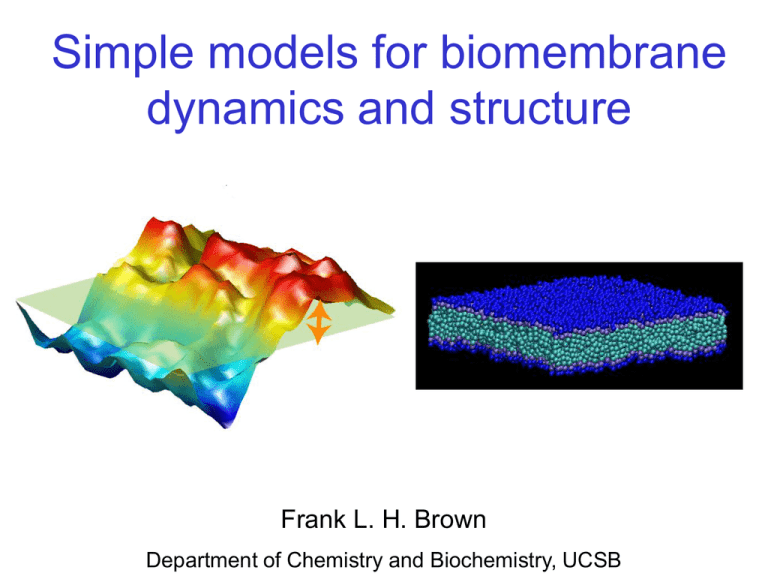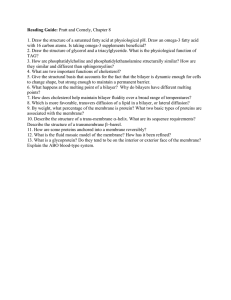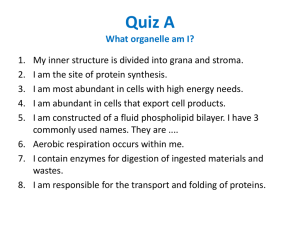Simple models for biomembrane dynamics and structure Frank L. H. Brown
advertisement

Simple models for biomembrane dynamics and structure Frank L. H. Brown Department of Chemistry and Biochemistry, UCSB Limitations of Fully Atomic Molecular Dynamics Simulation A recent “large” membrane simulation (Pitman et. al., JACS, 127, 4576 (2005)) •1 rhodopsin, 99 lipids, 24 cholesterols, 7400 waters (43,222 atoms total) •5.5 x 7.7 x 10.3 nm periodic box for 118 ns duration Length/time scales relevant to cellular biology •ms, m (and longer) •A 1.0 x 1.0 x 0.1 m simulation for 1 ms would be approximately 2 x 109 more expensive than our abilities in 2005 • Moore’s law: this might be possible in 46 yrs. Outline • Elastic simulations for membrane dynamics – Protein motion on the surface of the red blood cell – Supported bilayers and “active” membranes • Molecular membrane model – Flexible lipid, solvent-free • Correspondence with experimental physical properties and stress profile • Protein induced deformation of the bilayer • Elastic model for peristaltic bilayer deformations – Fluctuation spectra – Protein deformations Linear response, curvature elasticity model L Helfrich bending free energy: 2 Kc Kc 2 2 4 E h(r ) dxdy 2 k hk 2 2L k h(r) Linear response for normal modes: d hk t k hk (t) dt K ck 3 k 4 Kc: Bending modulus L: Linear dimension T: Temperature : Cytoplasm viscosity Ornstein-Uhlenbeck process for each mode: P(hk ) Kc k 4 Kc k 4 2 exp h 2 2 k 2 kB TL 2k B TL K k 4 h (t) h (0)e k t 2 Kc k 4 k k c Phk (t ) | hk (0) exp 2 t 2 t 2 k BTL2 (1 e k ) 2k BTL2 (1 e k ) Relaxation frequencies Solve for relaxation of membrane modes coupled to a fluid in the overdamped limit: Non-inertial Navier-Stokes eq: p 2 u fext u 0 Nonlocal Langevin equation: K ck 3 k 4 hÝ(r,t) dr' H(r r' ) f (r ' ,t) (r ,t) H(r ) 1 8r f (r ) E h(r ) Oseen tensor (for infinite medium) Bending force R. Granek, J. Phys. II France, 7, 1761-1788 (1997). 1 4 ˆ( k,t) Ý hk (t ) Kck hk (t) 4k Generalization to other fluid environments is possible Different viscoscities on both sides of membrane Membrane near an Impermeable wall And various combinations Membrane near a semi-permeable wall Seifert PRE 94, Safran and Gov PRE 04, Lin and Brown (In press) Membrane Dynamics QuickTime™ and a decompressor are needed to see this picture. Extension to non-harmonic systems Helfrich bending free energy + additional interactions: 2 Kc Kc 2 2 4 E h(r ) dxdy V[h(r)] 2 k hk Vk [h(r)] 2 2L k Overdamped dynamics: d dr ' H(r r ') f (r ',t) (r,t) dt hk t k Fk [h(r,t)] k (t) E f (r ) 1 (or generalized h(r ) k 4k expressions) Solve via Brownian dynamics hÝ(r ,t) •Handle bulk of calculation in Fourier Space (FSBD) •Efficient handling of hydrodynamics •Natural way tocoarse grain over short length scales L. Lin and F. Brown, Phys. Rev. Lett., 93, 256001 (2004). L. Lin and F. Brown, Phys. Rev. E, 72, 011910 (2005). Protein motion on the surface of red blood cells S. Liu et al., J. Cell. Biol., 104, 527 (1987). S. Liu et al., J. Cell. Biol., 104, 527 (1987). Spectrin “corrals” protein diffusion •Dmicro= 5x10-9 cm2/s (motion inside corral) •Dmacro= 7x10-11 cm2/s (hops between corrals) Proposed Models Why membrane undulations? • The mechanism has not been considered before. • “Thermal” membrane fluctuations are known to exist in red blood cells (flicker effect). • Physical constants necessary for a simple model are available from unrelated experiments. Dynamic undulation model Dmicro Kc=2x10-13 ergs =0.06 poise L=140 nm T=37oC Dmicro=0.53 m2/s h0=6 nm F. Brown, Biophys. J., 84, 842 (2003). Explicit Cytoskeletal Interactions • Harmonic anchoring of spectrin cytoskeleton to the bilayer Kc E A d r 2 h(r ) 2 2 1 V(r)h 2 (r) 2 V(r) (r Ri ) i • Additional repulsive interaction along the edges of the corral to mimic spectrin Frep dr e h (r ) / A (ax by i i L. Lin and F. Brown, Biophys. J., 86, 764 (2004). L. Lin and F. Brown, Phys. Rev. Lett., 93, 256001 (2004). i ci ) Dynamics with repulsive spectrin QuickTime™ and a decompressor are needed to see this picture. Information extracted from the simulation •Probability that thermal bilayer fluctuation exceeds h0=6nm at equilibrium (intracellular domain size) •Probability that such a fluctuation persists longer than t0=23s (time to diffuse over spectrin) •Escape rate for protein from a corral •Macroscopic diffusion constant on cell surface (experimentally measured) Calculated Dmacro • Used experimental median value of corral size L=110 nm System Size Simulation Type Simulation Geometry Dmacro (cm2s-1 ) L Free Membrane Square L Pinned Square Pinned Square 9 1012 5 10 12 7 1010 Pinned & Repulsive Square Pinned & Repulsive Triangular • Median experimental value Dmacro 6.6 10-11 cm2s-1 3.4 1010 2 1010 Fluctuations of supported bilayers Y. Kaizuka and J. T. Groves, Biophys. J., 86, 905 (2004). Lin and Brown (submitted). Fluctuations of supported bilayers (dynamics) Impermeable wall (different boundary conditions) No wall x10-5 Timescales consistent with experiment Way off! Fluctuations of “active” bilayers Fluctuations of active membranes (experiments) J.-B. Manneville, P. Bassereau, D. Levy and J. Prost, PRL, 4356, 1999. kon Off Off koff kon koff Push down Push up L. Lin, N. Gov and F.L.H. Brown, JCP, 124, 074903 (2006). Summary (elastic modeling) • Elastic models for membrane undulations can be extended to complex geometries and potentials via Brownian dynamics simulation. • “Thermal” undulations appear to be able to promote protein mobility on the RBC. • Other biophysical and biochemical systems are well suited to this approach. Molecular membrane models with implicit solvent Why? • Study the basic (minimal) requirements for bilayer stability and elasticity. • A particle based method is more versatile than elastic models. – Incorporate proteins, cytoskeleton, etc. – Non “planar” geometries • Computational efficiency. A range of resolutions... W. Helfrich, Z. Natuforsch, 28c, 693 (1973) J.M. Drouffe, A.C. Maggs, and S. Leibler, Science 254, 1353 (1991) Helmut Heller, Michael Schaefer, and Klaus Schulten, J. Phys. Chem 1993, 8343 (1993) Y. Kantor, M. Kardar, and D.R. Nelson, Phys. Rev. A 35, 3056 (1987) R. Goetz and R. Lipowsky, J. Chem. Phys. 108, 7397 (1998) Motivation D. Marsh, Biochim. Biophys. Acta, 1286, 183-223 (1996). A solvent free model G. Brannigan, P. F. Philips and F. L. H. Brown, Phys. Rev. E, 72, 011915 (2005). Self-Assembly QuickTime™ and a YUV420 codec decompressor are needed to see this picture. (128 lipids) Phase Behavior Fluid (kBT = 0.9) “Gel” (kBT = 0.5) Flexible (and tunable) kc: 1 - 8 * 10-20 J kA: 40-220 mJ/m2 Stress Profile (-surface tension vs. height) R. Goetz and R.Lipowsky, JCP 108 p. 7397, (1998) Explicit Solvent Implicit Solvent Protein Inclusions Single protein inclusion in the bilayer sheet Inclusion is composed of rigid “lipid molecules” Deformation of the bilayer data fit to elastic r h(r) h0 h0 H. Aranda-Espinoza et. al., Biophys. J., 71, 648 (1996). G. Brannigan and FLH Brown, Biophys. J., 90, 1501 (2006). The fit is meaningful Deformation profile has three independent constants formed from combinations of elastic properties h0 0 kc kA c0 c0 ’ monolayer thickness area/lipid bending modulus Stretching modulus Spontaneous curvature (monolayer) area derivative of above Using physical constant inferred from homogeneous bilayer simulations we can predict the “fit” values. Direct from simulation Thermal fluctuations Infer from stress Profile & fluctuations A consistent elastic model protrusion bending •Begin with standard treatment for surfactant monolayers (e.g. Safran) •Couple monolayers by requiring volume conservation of hydrophobic tails and equal local area/lipid between leaflets •Include microscopic protrusions (harmonically bound to z fields & include interfacial tension) A consistent elastic model k c 2 2 2 2 z k int 2 intz dxdy 2 A kA 2 z 2 kc 2 2 2 ' 2 z 2k c c 0 z 2kc c 0 c 0 0 z z t0 2 2t 0 k int 2 intz 2 2 Undulations (bending & protrusion) k Peristaltic bending Peristaltic protrusions (and coupling to bending) c : Monolayer bending modulus 2 k : Protrusion binding constant int: Interfacial (water/hydrocarbon) tension kA : Monolayer compressibility modulus 2 c 0 : Monolayer spontaneous curvature A consistent elastic model •Predicts thermal fluctuation amplitudes for both undulation and peristaltic modes –Continuous as function of q –Spontaneous curvature included –Elastic constants are interrelated –5 fit constants over two data sets •Predicts response to hydrophobic mismatch –Same elastic constants as fluctuations –Protrusion modes explicitly considered Fits to fluctuation spectra Lindahl &Edholm Marrink & Mark Scott & coworkers hq tq 2 2 kB T kB T k c q 4 2k intq 2 kB T kcq4 4 kc 2 c 0 c '0 0 q 2 k A /t 0 t0 kB T 2k intq 2 Effect of spontaneous curvature Positive spontaneous curvature & conservation of volume favors modulated thickness These molecules are unhappy, but, there are relatively few of them. These molecules are happy because they’re in their preferred curvature. Fluctuation spectra: spontaneous curvature Of the available simulation data, this effect is most pronounced for DPPC: QuickTime™ and a TIFF (LZW) decompressor are needed to see this picture. Lindahl, E. and O. Edholm. Biophysical Journal 79:426(2000) gramicidin A channel lifetimes Rate vs. monolayer thickness ) e Fela s (TS )Fela s (D )1 (Fela s (TS )Fela s (D )) ) e 2 (1) 0 (2) 0 kd (z kd (z In progress… Free energy calculations to establish potential of mean force. Summary •Implicit solvent models can reproduce an array of bilayer properties and behaviors. •Computation is significantly reduced relative to explicit solvent models, enabling otherwise difficult simulations. •A single elastic model can explain peristaltic fluctuations, height fluctuations and response to a protein deformations (if you include spontaneous curvature and protrusions) Acknowledgements Lawrence Lin Grace Brannigan Adele Tamboli Peter Phillips Jay Groves, Larry Scott, Jay Mashl Siewert-Jan Marrink Olle Edholm NSF, ACS-PRF, Sloan Foundation,UCSB

